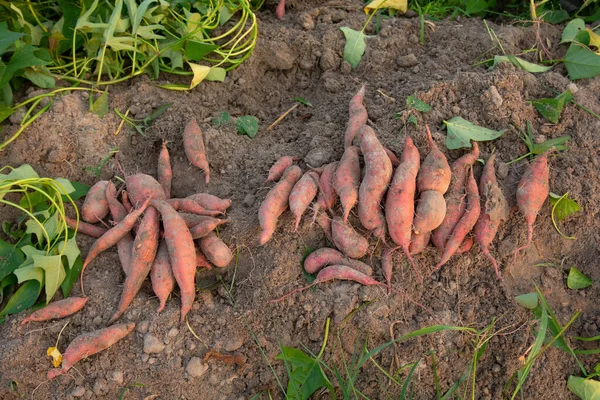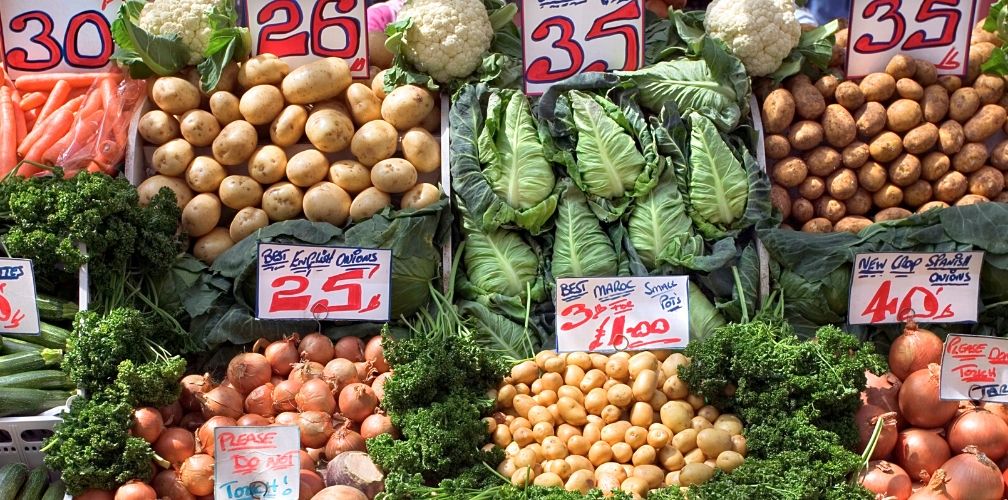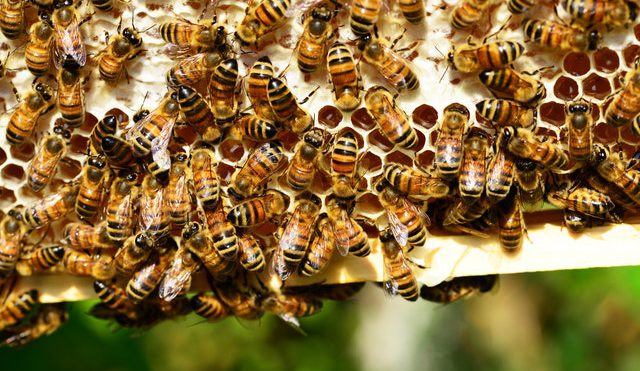Are you wondering if sweet potato farming is profitable in Kenya? In this post, we will give you an estimate of the money you can make for growing and selling crop tubers and vines. The analysis will use the cost and benefits analysis (CBA) method to determine the costs, profits and gross margins
The revenues for your sweet potato farming are from selling its tubers. To make more money you can sell vines and leaves as livestock fodder and seeds to other farmers. The cost of growing one acre of sweet potato in Kenya is around Ksh 120,000. Your key expenses are for land hiring, leasing tractors and buying planting seeds. Other costs are for hiring labor for planting, weeding and planting as well as crop care costs buying and applying herbicides and fertilizers.
Table of contents
Why sweet potato farming?
Is it beneficial to grow and sell sweet potatoes? There are many advantages of farming the vegetables. The nutritious vegetable is a rich source of Vitamin A, dietary fibres, minerals and flavonoid anti-oxidants. In addition, its vines are a high-value livestock fodder for dairy cattle, sheep and goats due to their high crude protein (CP), palatability and digestibility. Other benefits of growing sweet potatoes are;
- Cheap-it is a low-input crop with very minimal expenses in buying pesticides and fertilizers.
- Sustainability- it is a drought-resilient crop. This guarantees you some food security, and profits if you are in an area affected by climate change.
- Organic farming- as a cover crop, can help your farm in weed suppression, controlling soil erosion and improving soil fertility naturally.
Is there a market for sweet potato products in Kenya?
There is a high demand for sweet potatoes in Kenya as a healthy and natural food. Roasted, boiled and deep-fried potatoes are a major breakfast meal in many households and hotels in the region. They are a cheaper substitute for bread and cakes which are also considered unhealthy processed food among middle-class families. Other factors growing the demand for sweet potato farming are;
- The production of sweet potato composite flours, cakes and snacks
- Starch processing
- Fodder preservation and manufacturing of livestock feed
- Supply of high-quality seeds, vines and cuttings to other farmers
You can easily market your sweet potato to merchants, brokers or factories. The key markets for Ngwaci are the major towns like Nairobi, Mombasa and Nakuru where many wholesalers. They contract farmers and purchase their tubers at wholesale prices on the farm.
Assumptions for Sweet Potato Farming GMA
- Costs such as salaries, levies, insurance, marketing and promotion are not factored in.
- Variable costs may change depending on the region
- Harvesting is done twice a year
- The establishment is done as per the production recommendations
- All other risk factors such as weather uncertainties, theft, crop destruction, pests and diseases are held constant
Revenues per acre of sweet potatoes Farming in Kenya?
Wondering about the amount of money you can make growing “viazi tamu” in Kenya? Your total revenues are a sum of selling tubers and vines as the key products. In turn, each is a product of yields per acre and the current market prices.
Sweet potato sales
The best yield of sweet potatoes per acre in Kenya is 40 bags of 100kg each. Your yields can range between 15-30 t/ha for the best varieties. Productivity will depend on various factors such as variety, soil fertility and your crop management practises.
The price of one bag of sweet potatoes in Kenya is Ksh.6,500 to Ksh.11,000. For this analysis, we will use an average price of Ksh 8500/ bag or Ksh 85 per kg The fluctuation in prices depends on supply and demand, transportation costs, and market competition.
Given the above assumptions, you can make ksh. 340,000/acre (8500* 40) from sweet potato tuber sales only
Sweet potato vine sales
The second line where you can make money from your sweet potato farm is marketing vines. These can be for livestock fodder or as planting seeds for other farmers.
The price for a sweet potato vine ranges from Ksh.3 to 5 and can even go higher depending on location, and cost of production among other factors. The expected yield of vines in an acre is 120,000. As such, by marketing your vines, you can make an extra Ksh 360,000.
You can therefore make Ksh. 0.7 million per acre in sweet potato farming in Kenya. Our estimates assume you will sell everything from your farm.
What are the Costs per acre of sweet potato farming in Kenya?
According to this post’s estimates, the cost of producing one acre of sweet potato is Ksh 113,000 in Kenya. Your expenses include costs of leasing land, soil testing and land preparation. Others are planting materials, fertilizers and weed control among others.
Land Hire
A good sweet potato farm can cost you up to Ksh 10,00 to hire per year. While the sweet potato can do well in any part of the country, the following are the general agroecological needs for best yields.
- Minimum rainfall: 750 – 1250 mm
- Altitude: 8 – >2,400 m ASL
- Soils: sandy-loam soils with a pH of 5.6 – 6.5
- Optimum temperature 20oC to 25oC
Land Preparation
The sweet potato farm should be cleared and crop residues or grass (trash) removed. The field is then ploughed and harrowed twice to have a fine tilth. The cost of hiring a tractor for this is usually between Ksh 1500 and 4000.
At the same stage, you can conduct soil testing to determine its nutrients and determine the best fertilizers. In Kenya, the cost of soil testing is Ksh 3500 per acre.
You can plant vines on ridges, mounds or flat seedbeds. The growing of sweet potatoes on the flat seed bed is not recommended because it has low yields. Early and thorough land preparation is necessary to create a deep loose seedbed ideal for the expansion of tubers
Sweet Potato seed selection
For high yields, look for clean planting materials and a variety that the market requires. The most traded variety of sweet potato in Kenya is the red-skinned and yellow-fleshed because of its high consumer demand. These varieties whose flesh is yellow-orange coloured have high levels of carotenes used in the synthesis of vitamin A. You can select varieties based on;
- colour of the tuber skin (usually white, brown-yellow, reddish purple),
- Tuber flesh colour (usually white or yellow),
- The shape of the tuber,
- Shape of the leaves
- depth of rooting
- time of maturity
- resistance to pests and diseases
The best sweet potato seeds to grow in Kenya include Kemb 10, SPK 004, KSP 20, KSP 11, CIP 420009, SPK 013, Kemb 23, Ex-Diani, Mafuta, Mugande Muibai, Japanese pumpkin, and CIP Selection 420009. On the other hand, if you want to focus on vine production buy the Kemb10, KSB 20, Ex-Mukurweini, Saparo, and Ex Musinya.
By buying each planting vine at Ksh 3, your total expenditure will be Ksh 66,000.
Planting
The recommended number of cuttings per hectare is 54,000 cuttings/ ha or (22,000 cuttings per acre). Make holes 15 cm deep at a spacing of 45 x 45 cm. For faster ground cover formation, closer spacing is recommended. Cut vines 30 – 60 cm long and cover 3/4 in the soil. Sweet potatoes can be planted at any time so long as there is sufficient moisture in the soil.
Assuming planting labour of 15 workdays each at Ksh 400, your expenditure will be Ksh 6000.
Fertilizer and Manure application
Looking for the best fertilizer for sweet potatoes? A soil test is recommended to determine the soil pH and the amount of lime and fertilizer needed for optimum crop growth. The general application recommendations are to add a handful of manure per hill/ hole at planting. For vegetative growth, apply compound fertilizer (NPK) at the rate of 60 Kg/Ha (24 kgs/ acre) after root establishment to avoid scorching. After around a month, you can top dress with 1 bag of CAN
Weed Control
Weeds are a problem in sweet potatoes during the first two months of growth. After this period, vigorous growth of the vines causes rapid and effective coverage of the ground surface and smothers the weeds present. Hand weeding twice after planting is recommended. The first weeding is done within 2 weeks after planting and the second weeding two weeks after the first one when earthing-up is being done.
Disease and Pest Control
The most common pests attacking sweet potatoes are mole rats, weevils, stem borer, butterflies and eriophyid mites
For pest control, take the following steps,
- Early planting and prompt harvesting to avoid dry periods.
- Practice good field sanitation
- Practice crop rotation.
- Use clean planting material.
The major Sweet potato disease is the sweet potato virus disease (SPVD), It is a virus disease which causes dwarfing of the plants, yellowing of vines in young leaves and excessive branching. The disease is a combination of 2 diseases; Sweet potato feathery mottle virus (SPFMV)and Sweet potato chlorotic stunt virus (SPCSV) which are spread by aphids and white flies. The other major notable disease is Fusarium Wilt. The best disease control tips involve;
- Plant the resistant or tolerant varieties
- Use healthy, clean, virus-free planting materials.
- Good field sanitation.
- Control the white flies.
Harvesting
Sweet potato cultivation involves harvesting young leaves for vegetables, vines for fodder and seeds and finally tubers. Young leaves from these vines can be harvested for vegetable use as early as 2 months after planting
Sweet Potato Vine (SPV) harvesting time varies between 3 to 5 months, depending on the specific variety being grown. Fodder varieties, in particular, yields between 12 to 20 tons of fresh vines per acre (or 30 to 50 tons per hectare). This harvesting routine results in approximately 120,000 vines per acre or 300,000 vines per hectare
Harvesting tubers is a vital stage in farming, with maturity typically ranging from 3 to 6 months after planting. Signs of readiness include the yellowing and drying of leaves, along with sap that doesn’t darken easily. An average yield of 10-20 tons/ha can be obtained from growing any of the above-mentioned varieties. it is important that the tubers are free of surface wounds and bruises which may reduce their storage life.
Storage
To ensure the tubers’ quality during storage, curing is performed by maintaining specific conditions: temperatures of 27-29.5°C and relative humidity of 85-90% for 4-7 days. Post-curing, the tubers are best stored at temperatures between 13-16°C.
Marketing
For successful marketing, the farmer should have signed sales contracts. The buyer should buy at the agreed price and also undertake to transport the tubers to the market.
Other tips for smooth marketing are forming farmer groups and cooperatives and also considerations of investing in processing and value addition.
Read Next: The 13 best processing and value addition ideas for sweet potato farmers in Kenya?
How Profitable is Sweet Potato Farming in Kenya?
According to the GMA in this post, the cost of producing one acre of sweet potato is Ksh. 200,00, per acre in Kenya. The expected returns per acre are Ksh. 700,000 assuming you sell vines and tubers. This translates to a gross profit margin of 71.4% (700,000-200,000 divided by 700,000) %. These figures suggest that sweet potato farming is a profitable agribusiness for farmers in Kenya.
To achieve such figures, you need to invest in the necessary resources and expertise. Besides, these figures are just estimates and you are encouraged to use actual figures.




Very informative to anyone who may want to venture into sweet potato agribusiness